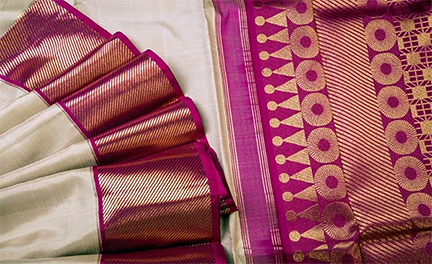Kanjeevaram Silk Sari: Tamil Nadu | 29 Jul 2021
Why in News
National award winning artisan weaver, B Krishnamoorthy, has created a repository with samples of all the designs, patterns and motifs traditional to Kanjeevaram silk sari weaving, preserving fine pieces for next generation.
Key Points
- About Kanjeevaram Sarees:
- Traditionally, the Kanjeevaram is a sari that is usually handwoven in mulberry silk and has pure gold or silver zari that renders it a festive quality.
- Handloom silk saree is identified as the most luxurious and classy fabric in Indian traditional clothing.
- Originating from the village ‘Kanchipuram’ in Tamil Nadu, Kanjeevaram is considered the queen of silk sarees.
- The temple architecture of south India and especially around Kanchipuram has historically served as a mood board for design inspiration for the traditional Kanjeevaram motifs.
- One can spot motifs such as the mythical creature called the Yali (an elephant-lion fusion), the Ganda Berunda (a two-headed majestic mythical bird) and the ubiquitous temple border called reku.
- Tracing its long and rich history from the Chola Dynasty, Kanchipuram sarees today are considered as one of the oldest and rich legacies of the Indian textile industry.
- Kanchipuram silk has also received Geographical indication (GI Tag) in 2005-06.
- Traditionally, the Kanjeevaram is a sari that is usually handwoven in mulberry silk and has pure gold or silver zari that renders it a festive quality.
- Other GI tagged Sarees:
- Tamil Nadu: Kandangi Saree, Thirubuvanam silk sarees, Kovai Kora Cotton Sarees
- Uttar Pradesh: Banaras Brocade
- Karnataka: Ilkal Saree, Molakalmuru Saree
- Andhra Pradesh: Uppada Jamdani Sarees, Venkatagiri Sarees, Mangalagiri Saree
- Kerala: Balaramapuram Sarees, Kasaragod Sarees, Kuthampully Sarees
- Telangana: Gadwal Saree, Pochampally Ikat (logo)
- Madhya Pradesh: Chanderi Saree, Maheshwar Sarees
- Odisha: Orissa Ikat, Bomkai Saree, Habaspuri Saree
- West Bengal: Santipore Saree, Baluchari Saree, Dhaniakhali Saree
- Maharashtra: Paithani Sarees and Fabrics, Karvath Kati Sarees and Fabrics
- Chhattisgarh: Champa Silk Saree
- Gujarat: Surat Zari Craft, Patola Saree.
- Silk Production in India:
- India is the second largest producer of silk in the world, producing around 18% of the world's total silk.
- There are five major types of silk of commercial importance, obtained from different species of silkworms. These are Mulberry, Oak Tasar & Tropical Tasar, Muga and Eri.
- Except mulberry, other non-mulberry varieties of silks are wild silks, known as vanya silks.
- India has the unique distinction of producing all these commercial varieties of silk.
- South India is the leading silk producing area of the country and is also known for its famous silk weaving enclaves like Kancheepuram, Dharmavaram, Arni, etc.
- The Government of India in 2017 launched a scheme called “Silk Samagra” for the development of sericulture in the country.

